Continuing conversations about big fishing trips, it seemed logical to look into the northern waters.
Sea fishing in the Arctic Circle is primarily associated with that in Norway, which is absolutely true – two-thirds of the country lies in the Arctic Circle, from the northwest it is washed by the Norwegian Sea, from the northeast by the Barents Sea, from the south by the Northern Sea, and the coastline is more than 25 thousand kilometers, not counting numerous islands and archipelagos.
Atlantic cod, reaching a weight of more than 60 kilograms, halibut, whose weight can reach 250 kilograms, coalfish, with a maximum weight of more than 30 kilograms. As well as haddock, wolffishes, ocean perches, hake, lings, flounders, anglerfish, mackerel, and even Atlantic tuna – an incomplete list of fish that can be caught in these northern sea waters.
Fishermen are attracted to Norway by both the opportunity to catch trophy fish and its fascinating northern beauty. But without understanding on what kind of fish, in what time of the year, and in what place one can count, the traveler, quite possibly, will be content with only admiring those very beauties.
In order to deal with fishing in Norway, adriaticnature without a doubt decided to turn to an expert of these places, a fisherman, the author of a detailed thematic Internet resource “Sea fishing in Norway” – Mikhail Dyshlyuk.
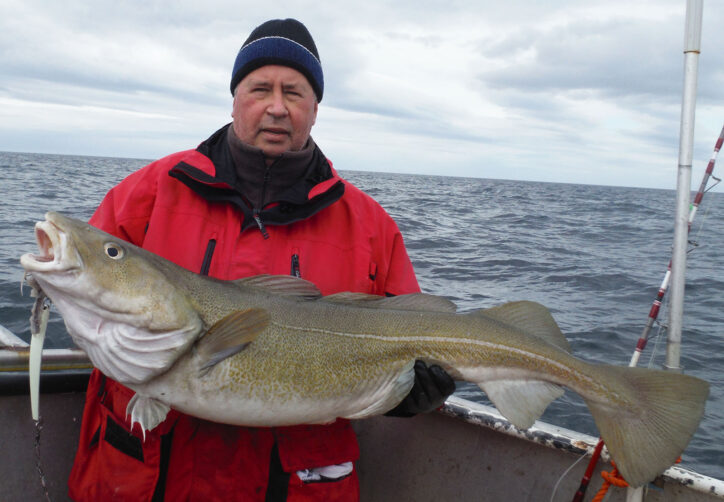
(Mikhail Dyshlyuk. Photo © norway-fishing.ru)
Mikhail, greetings, thank you for taking the time for our conversation. There is probably no more detailed resource than norway-fishing.ru about sea fishing in Norway. On it, one can find all the detailed information for both beginners and people who have had time to get acquainted with the question. However, I would like to run through its pages again, clarifying some details.
You are talking about the possibility of successful year-round sea fishing in Norway, except for the winter period, when the polar night falls on Norway. The trend is that the more northerly, the more severe the conditions of fishing and life become, but the greater the number and size of fish, the more southerly – on the contrary. However, a fisherman who is going to Norway for the first time will probably fall into a kind of stupor, not understanding where to go. How can you get rid of the agony of choice and make the right decision, so as not to be disappointed, on the one hand, from the difficulties accompanying fishing, and on the other – to count on decent catches?
Going on a sea fishing trip to Norway, the fisherman must answer himself a few questions:
The first is the purpose of the trip. Is it – just to catch different fish? Species fishing (to focus on one species)? Trophy fishing? The place of fishing, the time of year, gear, rigging, and equipment depend on it.
The largest and most diverse catches are in the north, beyond the Arctic Circle (but don’t let that scare you, in summer it can be up to 30 degrees Celsius). Therefore, for effective and beautiful fishing, it is better to choose the summer months, from June to early September.
Location: The best fishing is possible along the coast of the Norwegian Sea, approximately from the Lofoten Islands and north to Nordkapp. And on the other hand – in the Norwegian Barents Sea, approximately to the Repvåg peninsula. But it is also possible to fish quite well off the coast of central Norway, especially around Hitra Island, but there will be a slightly different species composition of catches.
The planning of species and trophy fishing primarily depends on the time of year. The best time for cod fishing is in early spring (late February-April). At this time, cod is spawning, which in Norway is called “skrei” (what is a skrei, you can read in detail here). And only in huge flocks of skrei can you catch trophy specimens of cod weighing 35 + kilograms. The location of such fishing is limited, from Nordkapp Cape to Lofoten, while trophy cod is almost not caught closer to Lofoten.
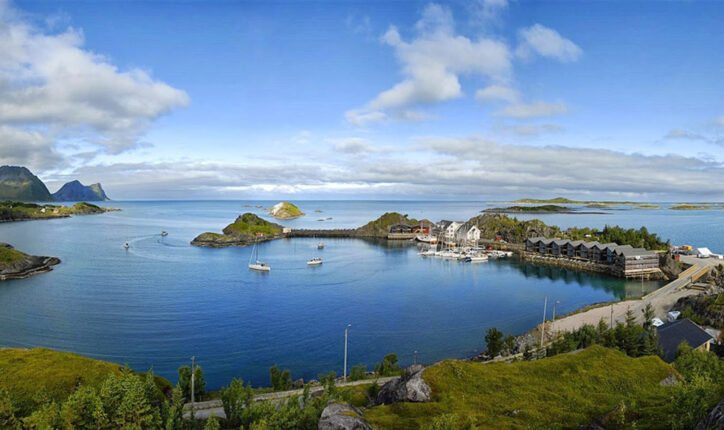
(Norwegian summer landscape. Photo © norway-fishing.ru)
It should be understood that cod fishing in the spring in Arctic Circle Norway is not the most comfortable time – the wind with snow in the sea requires very good equipment and certain endurance.
If the main purpose of the trip is halibut fishing, then these are usually the summer months, and also in the north. Below Lofoten, the probability of catching halibut is rapidly decreasing. It should be borne in mind that halibut fishing is not at all simple and largely depends on knowledge of a specific water area, experience, an arsenal of rigs, and baits. Therefore, catches will be measured in units. And trophy fish of 50 + kilograms are reduced to a lottery at all. From my experience, it is more or less real to catch a small (up to 10-15 kg) halibut only in the waters of the island of Sørøya.
Catching large coalfish and whiting (aka European hake) is most effective in summer in central Norway, in the waters of the islands of Hitra and Freyja.
The second question is the composition of the group. If you are planning a trip with your family, friends, or children, you need to keep in mind that in the north of Norway, after fishing, there is usually nothing to do on the shore. Especially if it is assumed that someone will stay on the shore while the father of the family is fishing in the sea.
The third question is the number of fishermen in the group. It should be borne in mind that fishermen are usually provided with 6-7-meter boats at Norwegian bases, and they manage them themselves. In such a boat, 3 people can comfortably catch, a maximum of four. At least two, it is forbidden to go out to sea alone.
And there are rules. In Norway, there are certain rules of sea fishing for tourists both when fishing and when exporting the catch. You can get acquainted with them here.

(“Skreis”. Photo © norway-fishing.ru)
The main method of fishing predatory fish in Norway is fishing “in a plumb line” from boats at great depths on heavy jigs – pilkers, jig heads with silicone or a nozzle of animal origin, “sabiki” with heavy loads. The weight of these jigs and rigs ranges from several hundred grams to one and a half kilograms. And, accordingly, this is fishing with the help of special gear – powerful marine spinning rods for fishing in these conditions and specialized multiplier reels. These tackle and jigs are practically not used in other situations, for example, for ”offshore” fishing in tropical seas or in the Mediterranean Sea. Should a fisherman prepare for fishing in Norway by purchasing rods, reels, and jigs, or is it possible to rent them at fishing bases? And, if this is possible, what do you still need to take with you from home?
Firstly, I do not agree that “Norwegian” gear is not used in the tropics. When fishing for bait in a plumb line on reefs, when fishing for rays, sharks, and so on, almost the same spinning rods and reels are used.
In my opinion, for fishermen with experience in any kind of fishing, a tackle is like a toothbrush, they should be their own. But, Norwegian fishing is a specific case. In general, it is extremely simple, but effective and does not require special knowledge and skills. That’s why it’s so attractive.
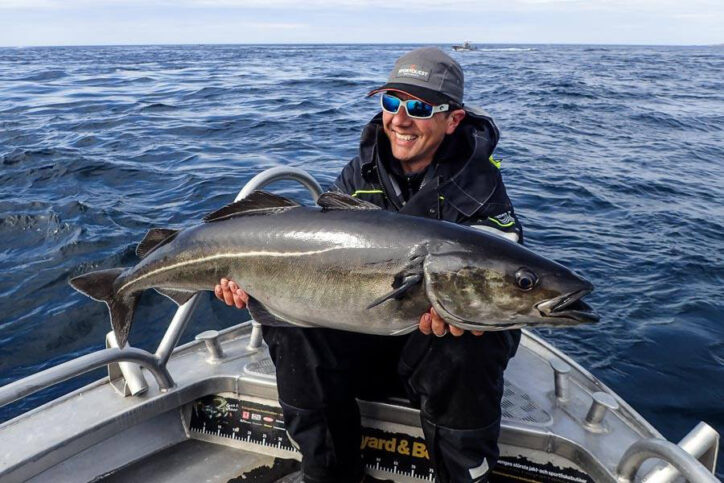
(Pollock. Photo © norway-fishing.ru)
The gear is also very simple and clear. The minimum set consists of a rod of 1.8-2.4 m with a test of 600 grams, a medium-sized multiplier reel with a braided cord of 0.35-0.45 mm, equipped with a stake with hooks and a jig weighing 500-800 grams. For ordinary fishing, this is quite enough. The simplicity of the minimum required fishing kit allows Norwegian fishing bases to organize the inexpensive rental of such sets of gear.
But there are nuances. Fishing is always associated with possible breaks of jigs, especially in the sea. Reefs, corals, rocky bottom do their job. You will be given only one stake and one pilker for rent. Therefore, you still have to stock up on something at home.
You should buy 2-3 more stakes with 10/0 – 12/0 hooks (most often special “Gummy Makk” hooks are used, imitating a sand eel or an eel larva). There must be 2-3 pilkers weighing 500-700 g in stock. The most popular are the so-called Norwegian triangular. This is the minimum that will allow you to confidently fish cod and coalfish, and any other fish can be in the by-catch.

(Hooks “Gummy Makk”. Photo © norway-fishing.ru)
If we are talking about more “advanced” fishing of various types of fish, including bottom fishing, halibut fishing, and so on, and even more trophy fishing, then this is a completely different story. As in any other variant of specialized fishing, the number of options for gear, rigging, and jigs tends to infinity.
Equipment and outfit are separate topics. Some things are in the boats (boat hooks), some things can be rented (suits, life jackets), and some things will also have to be purchased.
You should remember that it is necessary to order gear rental right away, even at the stage of booking a trip.
You can read more about what is caught in Norwayhere.

(Cod caught on hooks “Gummy Makk”. Photo © norway-fishing.ru)
What criteria should be followed when searching for a particular fishing base for a trip? Is it possible to face any problems by making a mistake in the choice, if this is technically possible? Is it worth carefully studying the “water engine park” offered by one or another operator, or do all boats more or less meet the requirements of the upcoming fishing?
The most important selection criterion is the location of the base. Good fishing, as a rule, is possible only in the open sea, in fjords and skerries fish are caught noticeably worse, and it is significantly smaller. The only exception can be very large fjords, actually bays, and then only those closest to the outlet to the sea. Therefore, it is important that you can go 10-15 km (sometimes even further) from the fishing base into the open sea in a reasonable time, in an hour and a half.
It is also important to study the fishing area in advance using the depth map (for example, this one) in order to understand the prospects of fishing in advance, as well as to look for fishing options in case of bad weather (storm) somewhere under the cover of the coast or islands.
If fishermen are preparing to catch skrei in the spring, then it should be remembered that its main flocks, as a rule, move 10-15 km from the Nordkapp to the Lofoten Islands and back.
Halibut are caught approximately the same way (2-3 bites per day) in the same water area (Nordkapp – Lofoten Islands), but plus on the Norwegian coast of the Barents Sea. There is an exception – in the waters of Sørøya Island, a medium-sized halibut (10 kg +) can bite quite intensively. There have been cases of up to 10-15 bites per boat per day. This is explained by the fact that in the fjords of the island in the summer, “halibut” youth growth, some of which then lingers nearby.
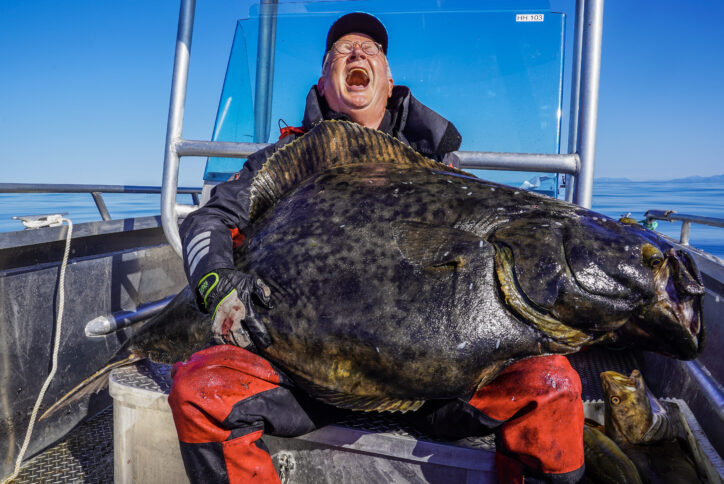
(Atlantic halibut. Photo © norway-fishing.ru)
Those who want to focus on catching sea bass should keep in mind that it is not well caught everywhere, and when planning a trip, you need to study the reports of fishermen or consult with those who love and know such fishing. One of these places is the water area of Senja Island.
As for the water-engine fleet – now in Norway, most fishing bases massively use boats of approximately the same characteristics, most often metal, 6.5-7 m long with engines from 50 to 115 hp. It is good if the boat has a wheelhouse in which you can take refuge on the crossings, hiding from the spray or rain. As I have already said, up to 4 people can fish from such boats, but two or three are comfortable. The coverage of the water area in search of fish also depends on the power of the motor.
There are, of course, larger and more powerful boats (with the same passenger capacity), but there are also open motorboats with engines of 20-40 hp in some places, you should not go fishing in the open sea on such.
An important issue is the equipment of the boat. First of all, this is electronics: a chartplotter and an echo sounder must be present. More often boats have devices in which these two gadgets are combined.
When booking a tour, it is worth clarifying whether the boats are equipped with boat hooks, and if not, you will have to take them with you. But now this rarely happens.

(Fishing Norwegian fleet. Photo © norway-fishing.ru)
The boats are operated by fishermen themselves. If there are problems with the operating of the boat, you can hire a guide, but it’s not cheap and you also need to arrange in advance when booking. With the license or certificates to operate the ship, the situation is as follows: those born before 01.01.1980 do not need any documents. Those who were born later, theoretically, should have a license or an international certificate (ICC) to operate vessels up to 15 meters long. But even law-abiding Norwegians are still turning a blind eye to this.
Petrol is not included in the booking price. Tourists are responsible for damage to the boat or motor. As a rule, upon arrival at the base, fishermen sign a contract in which all the conditions are stipulated, and a deposit is also made (more often about 500 euros). The cost of used gasoline will be deducted from this money during the calculation.
Boats at Norwegian fishing bases are “sharpened” for sea fishing, and allow you to go out to sea and fish with winds up to 7 m/sec, they are quite safe and convenient.
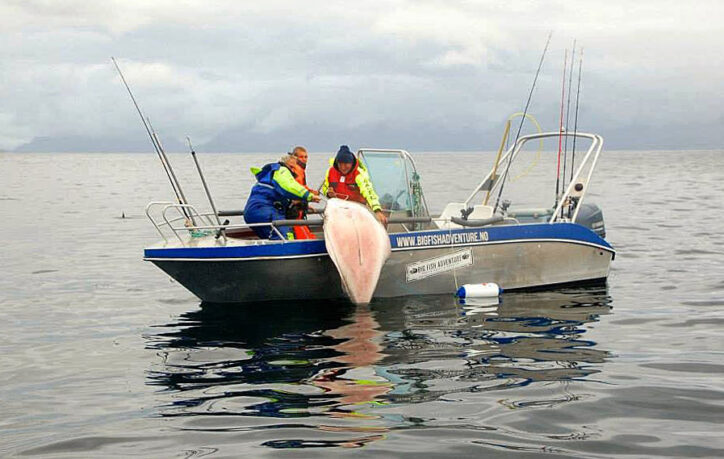
(Fishing Norwegian fleet in action. Photo © norway-fishing.ru)
For a long time, many fishermen have been observing the principle of “catch and release”. How possible is “catch and release” fishing in the process of offshore fishing in Norway, because fish come on board after a serious struggle and from great depths? With what types of fish C&R is possible, with which it is not, and what should fishermen do with those trophies that cannot be returned to their native element after being caught?
Pelagic fish species can be released. These are primarily coalfish, pollack, haddock, and others.
Cod also seems to be a pelagic fish and lives in the water column, but ichthyologists say that if it is quickly raised to the surface, it has micro-injuries, and after returning to the sea after some time, it still dies. Here you should think about the use of electric coils, is it worth it: with their help, the fish rises quickly.
But with the playing of large cod, the situation is different, it has to be lifted slowly, pumping it out, and its “decompression” goes well – you can safely release it.
“Flat” fish – halibut, flounder – are not afraid of rising from the depths.
From the ”bottom fish”, the ascent from the depth is fatal for the sea (red) bass, blue ling, whiting. But barotrauma does not occur in wolffishes, as well as in the sea devil (but, however, I do not remember that someone released such a rare trophy).
Caught fish, which no longer makes sense to send to their native element, but which is not needed, is still left in the sea, it will fit into the marine food chain.

(Halibuts. Photo © norway-fishing.ru)
How possible is fishing from the shore in Norway? In the last decade, such fishing methods as shore-jigging have become firmly established in the practice of fishermen. And fishing for wobblers, surface or silicone jigs in the southern seas has long shown its effectiveness. After all, there is often a time and a place for the sea ultralight. Are these fishing methods practiced in the Norwegian seas? Should fishermen who want to stay on the mainland or islands take shore gear with them?
Theoretically possible, in fact – rarely occurs. On social networks, there are reports of several, the same, Norwegian fishermen, and nothing more. There are several reasons, in my opinion.
Firstly, there are practically no large fish near the shore. The coastal fisherman’s catch will be specimens weighing from a kilogram to a kilogram and a half, like a decent fish by “freshwater” standards. But when a boat full of fish from 5 to 15 kg docks is nearby, it becomes clear that fishing from the shore in Norway is a relative waste of time. In addition, for example, it is simply forbidden to take cod less than 45 centimeters.
For the sake of fairness, I must say that from time to time you can “hook” something decent, weighing 7-10 kilograms +, on the coastal tackle, but this is a rare case.

(Michael Eisele with a record 47.2 kg cod caught by an angler. Photo © norway-fishing.ru)
In addition, in the northern seas, at a depth where light penetrates, lush vegetation grows on the bottom, and algae are so powerful that it is almost impossible to snatch the jigs from them. This greatly limits the use of classic jig and bottom rigs, and spoons with wobblers also remain on them regularly.
Secondly, in Norway, especially in the north, it is difficult to approach the coastline: there are practically no roads to the coast, there are no beaches either, surf fishing is rarely possible, and climbing the rocks is very dangerous.
The only type of coastal fishing that, in my opinion, may be of interest in Norway is flounder fishing. Both my friends and I sometimes take with us a “light” spinning rod (with an upper test of up to 60-80 grams) when we know that the fishing base has an approach to the shore to places with sandy or flat rocky bottom without vegetation. Then, in bad weather, when it is impossible to go out to sea because of the wind, you can have fun catching flounders.
However, if you are interested in the fishing process itself, it is quite possible to pull mackerel or coalfish of about a kilogram weight on a light rod and the “Acme Kastmaster” in the evening before dinner – sea fish is much stronger than freshwater ones.
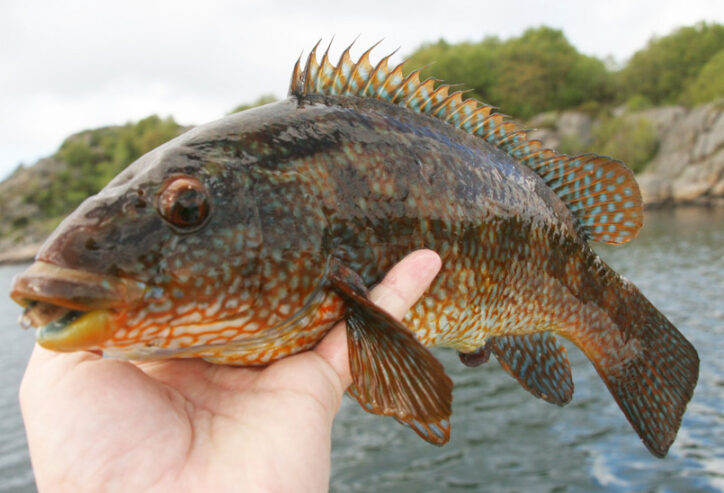
(Ballan wrasse. Photo © norway-fishing.ru)
If your personal “top” of jigs exist, what is it? Which of them can be safely recommended to keep on hand for fishermen traveling to Norway? Is it worth paying special attention to the colors of jigs, and if so, which ones?
As I have already said, there is a universal rig for standard fishing – a pilker on a stake with “Gummy Makk” hooks. The pilker should preferably be chrome-plated, polished. The most universal color of hooks is red, with light-accumulating tips, and completely light-accumulating for depths greater than 100 m.
As for me, I have long preferred catching trophy cod and halibut. Sometimes, “for my own pleasure”, I can catch catfish, as well as blue ling and whiting, if fate brings me to central Norway.
Therefore, my “top” of jigs is as follows:
Halibut fishing:
Artificial jigs: for fishing in the drift, these are giant jig heads (you can read about this method of fishing here). The most, in my opinion, catchy ones are Royber weighing 600-800 g pink (Pink Pussy) and Savage Gear 460 gPuffin coloring. For fishing in casting in calm or with a sand eel – jig-heads, imitation of a gerbil fish, weighing 150-300 grams.

(Coloring “puffin”. Photo © norway-fishing.ru)
Bait fishing: in some cases, especially at shallow depths, dead fish fishing is more successful than silicone. For this, simple equipment is used.
Cod fishing:
If I fish cod to solve the “food program”, I use a standard tackle – a pilker and a stake, but I have homemade pilkers, a curved tube, and necessarily with two hooks. According to our observations, half of the fish’s bites occur across the pilker. Such a pilker is quite versatile and does not “collect” a “trifle” weighing up to 5 kilograms.
For trophy cod fishing of 15+ kilograms, I use giant jig heads with one large single hook. Most often these are large Savage Gear 3D 35 cm long or a large-sized Royber Screi Jig.
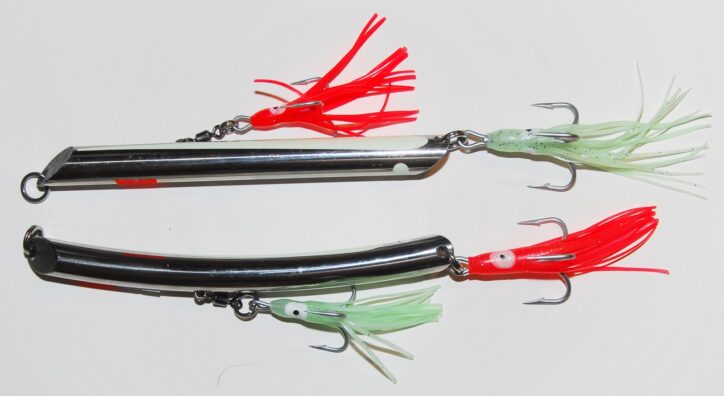
(Hand-made jig. Photo © norway-fishing.ru)
Wolffish fishing:
I catch it on the bait with the bottom rig “on knock“, which exactly repeats the rig for catching dead fish, only the tackle is replaced – a leash about 40 cm long and a double are put.
Blue ling fishing:
The equipment is used the same as when catching catfish, but the leash is knitted longer, a meter – meter and a half, and it is advisable to use any light-accumulating “attractive” – octopus, tubes, balls.
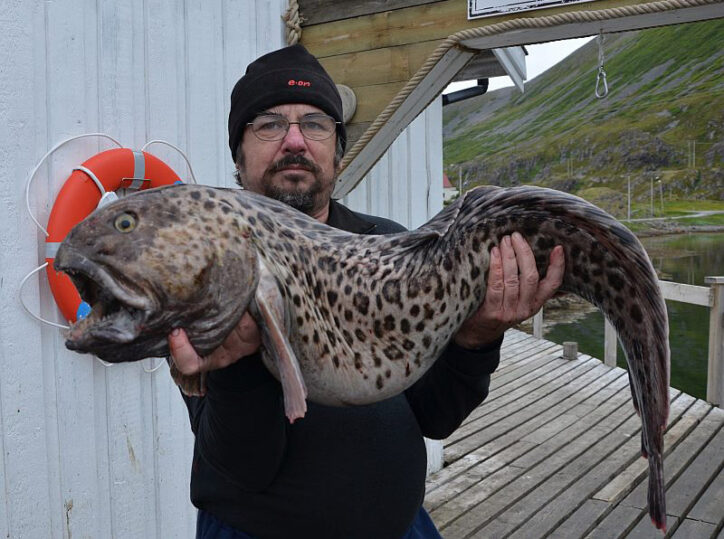
(Spotted wolffish. Photo © norway-fishing.ru)
Whiting fishing:
Giant jig heads, like for halibut fishing, but a little lighter, 500-600 grams. And it is better to use colors imitating herring, coalfish, mackerel.
An important point. When purchasing giant jig heads, you should remember that the weight indicated on them is the weight of the head itself. And with a large “silicone” it will be noticeably heavier, for example, a 600-gram Royber head with a 32-centimeter-long vibrating tail assembly will weigh 900 grams, that is, almost a kilogram.
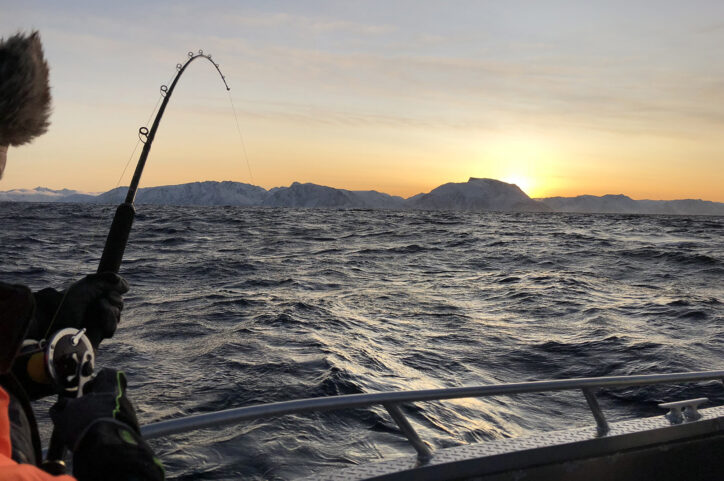
(Tight lines! Photo © norway-fishing.ru)
Tight lines!